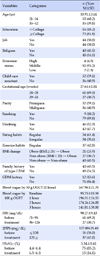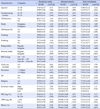Abstract
Purpose
The purpose of this study was to examine the relationship among emotional clarity in emotional intelligence, maternal identity, and fetal attachment to measure how emotional clarity and maternal identity impact on fetal attachment and to determine mediating effects of maternal identity in pregnant women at the time of diagnosis with gestational diabetes mellitus (GDM).
Methods
This study used a correlational survey design. 88 pregnant women with GDM completed a study questionnaire of emotional clarity, maternal identity, and fetal attachment immediately after the diagnosis of GDM. Data were analyzed Mann-Whitney U test, and ANOVA with Duncan test, Pearson correlation, three-step regressions to test mediating effect, and Sobel test.
Results
The emotional clarity was positively related with maternal identity and fetal attachment. It affected maternal identity with 21.9% of explained variance. The emotional clarity and the maternal identity were significant predictors of fetal attachment by 57.7% of explained variance. The maternal identity mediated the relationship between emotional clarity and fetal attachment.
Figures and Tables
 | Figure 1Mediating effects of maternal identity in the relationship between emotional clarity and fetal attachment. |
Table 1
Demographic and Clinical Characteristics of Subjects (N=88)

Table 2
Emotional Clarity, Maternal Identity, and Fetal Attachment according to Subjects' Characteristics (N=88)

Table 3
Relationships among Emotional Clarity, Maternal Identity, and Fetal Attachment (N=88)

Table 4
Mediating Effects of Maternal Identity in the Relationship between Emotional Clarity and Fetal Attachment (N=88)

EC=emotional clarity; MI=maternal identity; FA=fetal attachment; d (du)=Durbin-Watson's upper bound; K-S=Kolmogorov-Smirnov's normality test; χ2 by Breusch-Pagan's equal variance test; Adjusted by DM family history, religion; DM family history=dummy variable (No=0, Yes=1), Religion=dummy variable (No=0, Yes=1).
Summary Statement
▪ What is already known about this topic?
Adaptation to motherhood roles and the fetal attachment were positive predictors of prenatal health practices. The emotional intelligence could impact on health outcomes positively in diabetes mellitus patients, while evidence is limited with gestational diabetes mellitus.
▪ What this paper adds?
The emotional clarity was newly identified as a positive predictor of maternal identity and the fetal attachment with the mediating effect of maternal identity for pregnant women in gestational diabetes mellitus.
▪ Implications for practice, education and/or policy
An emotional intelligence program combined with diabetic nursing education may be helpful for pregnant women in gestational diabetes millitus to achieve better health outcomes of glycemic management, maternal identity, and fetal attachment.
References
1. Korean Diabetes Association. Standards of medical care in diabetes. Seoul: Korean Diabetes Association;2015. p. 244.
2. Koo BK, Lee JH, Kim J, Jang EJ, Lee CH. Prevalence of gestational diabetes mellitus in Korea: A national health insurance database study. PLoS One. 2016; 11(4):e0153107.

3. Kang HS, Lee HJ, Hyun MS. Trends in diabetes mellitus during pregnancy: Prevalence and health care utilization. J Korean Soc Matern Child Health. 2010; 14(2):170–180.
4. Daniells S, Grenyer BF, Davis WS, Coleman KJ, Burgess JA, Moses RG. Gestational diabetes mellitus: Is a diagnosis associated with an increase in maternal anxiety and stress in the short and intermediate term? Diabetes Care. 2003; 26(2):385–389.

5. Rumbold AR, Crowther CA. Women's experiences of being screened for gestational diabetes mellitus. Aust N Z J Obstet Gynaecol. 2002; 42(2):131–137.

6. Lustman PJ, Clouse RE. Depression in diabetic patients: The relationship between mood and glycemic control. J Diabetes Complications. 2005; 19(2):113–122.
7. Kim H. Development and evaluation of an integrated self-management program for women with gestational diabetes mellitus. J Korean Soc Matern Child Health. 2013; 17(1):1–14.
8. Baghdari N, Sahebzad ES, Kheirkhah M, Azmoude E. The effects of pregnancy-adaptation training on maternal-fetal attachment and adaptation in pregnant women with a history of baby loss. Nurs Midwifery Stud. 2016; 21. 5(2):e28949.

9. Kwon MK, Bang KS. Relationship of prenatal stress and depression to maternal-fetal attachment and fetal growth. J Korean Acad Nurs. 2011; 41(2):276–283.

10. Mercer RT. Maternal role attainment: Becoming a mother. In : Tomey AM, Alligood MR, editors. Nursing theorists and their work. 5th ed. London: Mosby;2002. p. 465–476.
11. Shin H, Park YJ, Ryu H, Seomun GA. Maternal sensitivity: A concept analysis. J Adv Nurs. 2008; 64(3):304–314.

12. Rasmussen B, Hendrieckx C, Clarke B, Botti M, Dunning T, Jenkins A, et al. Psychosocial issues of women with type 1 diabetes transitioning to motherhood: A structured literature review. BMC Pregnancy Childbirth. 2013; 13:218.

13. Salovey P, Mayer JD, Goldman SL, Turvey C, Palfai TP. Emotional attention, clarity, and repair: Exploring emotional intelligence using the Trait Meta-Mood Scale. In : Pennebaker JW, editor. Emotion, disclosure, and health. Washington DC: American Psychological Association;1995. p. 125–154.
14. Lee SJ, Lee HK. The research on the validation of the trait metamood scale: The domain exploration of the emotional intelligence. Korean J Soc Pers Psychol. 1997; 11(1):95–116.
15. Goldman SL, Kraemer DT, Salovey P. Beliefs about mood moderate the relationship of stress to illness and symptom reporting. J Psychosom Res. 1996; 41(2):115–128.

16. Kim MH, Hahm JS, Lee JH. The relationship between adult attachment and emotional awareness: Focused on emotional clarity and repair. J Korean Data Anal Soc. 2008; 10(6):3145–3156.
17. Zysberg L, Yosel TB, Goldman M. Emotional intelligence and glycemic management among type I diabetes patients. J Health Psychol. 2017; 22(2):158–163.

18. Yalcin BM, Karahan TF, Ozcelik M, Igde FA. The effects of an emotional intelligence program on the quality of life and wellbeing of patients with type 2 diabetes mellitus. Diabetes Educ. 2008; 34(6):1013–1024.

19. Maher H, Winston CN, S UR. What it feels like to be me: Linking emotional intelligence, identity, and intimacy. J Adolesc. 2017; 56:162–165.

20. Kim HW, Hong KJ. Development of a maternal identity scale for pregnant women. J Korean Acad Nurs. 1996; 26(3):531–543.

21. Chang SB, Kim KY, Kim ES. Changes of maternal-fetal attachment and self-efficacy for delivery after Taegyo-perspective parental class. J Women Health Nurs. 2001; 7(1):7–17.
22. Baron RM, Kenny DA. The moderator-mediator variable distinction in social psychological research: Conceptual, strategic, and statistical considerations. J Pers Soc Psychol. 1986; 51(6):1173–1182.

23. Park JE. Effective education strategies for women with gestational diabetes mellitus. J Korean Diabetes. 2012; 13(3):148–151.

24. Kim HS, Kim S. Effects of an integrated self-management program on self-management, glycemic control, and maternal identity in women with gestational diabetes mellitus. J Korean Acad Nurs. 2013; 43(1):69–80.

25. Son HJ, Park JS. Relationship between preterm labor stress, fetal attachment and maternal role confidence in pregnant women with preterm labor. J Korean Soc Matern Child Health. 2014; 18(1):86–96.
26. Devsam BU, Bogossian FE, Peacock AS. An interpretive review of women's experiences of gestational diabetes mellitus: Proposing a framework to enhance midwifery assessment. Women Birth. 2013; 26(2):e69–e76.

27. Yarcheski A, Mahon NE, Yarcheski TJ, Hanks MM, Cannella BL. A meta-analytic study of predictors of maternal-fetal attachment. Int J Nurs Stud. 2009; 46(5):708–715.

28. Im JO, Jang SS. A study on relationships among emotional clarity, emotional regulation style, and psychological well-being. Korean J Couns Psychother. 2003; 15(2):259–275.
29. Yang KM, Kim SL. Effects of a Taegyo program on parent-fetal attachment and parenthood in first pregnancy couples. J Korean Acad Nurs. 2010; 40(4):571–579.




 PDF
PDF ePub
ePub Citation
Citation Print
Print


 XML Download
XML Download